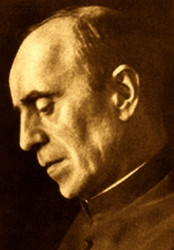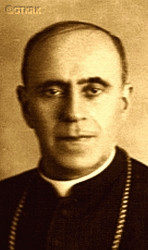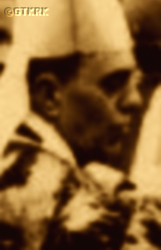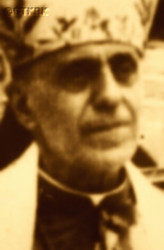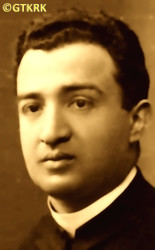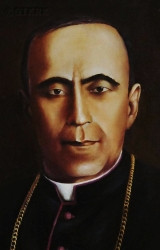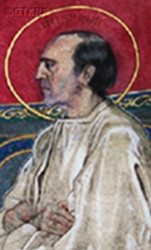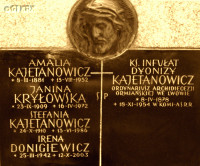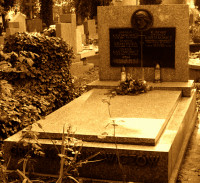Roman Catholic
St Sigismund parish
05-507 Słomczyn
85 Wiślana Str.
Konstancin deanery
Warsaw archdiocese, Poland
full list:
displayClick to display full list

searchClick to search full list by categories
wyświetlKliknij by wyświetlić pełną listę po polsku

szukajKliknij by przeszukać listę wg kategorii po polsku

Martyrology of the clergy — Poland
XX century (1914 – 1989)
personal data
surname
KAJETANOWICZ
forename(s)
Dennis (pl. Dionizy)
religious forename(s)
Roman
function
diocesan priest
creed
Armenian Catholic Church ACmore on
en.wikipedia.org
[access: 2013.05.19]
diocese / province
Lviv AC archeparchymore on
en.wikipedia.org
[access: 2017.01.21]
honorary titles
protonotary apostolic „supernumerary” (supra numerum)more on
en.wikipedia.org
[access: 2014.11.22]
Papal chamberlainmore on
en.wikipedia.org
[access: 2014.11.22]
(c. 1933)
Prelate‐provost (Lat. praelati‐praepositus)more on
en.wikipedia.org
[access: 2015.03.01]
(1933 – c. 1939, Assumption of the Blessed Virgin Mary AC cathedral church, Lvivtoday: Lviv urban hrom., Lviv rai., Lviv obl., Ukraine
more on
en.wikipedia.org
[access: 2022.01.16])
Minor Canonmore on
en.wikipedia.org
[access: 2014.11.14]
(1922 – , Assumption of the Blessed Virgin Mary AC cathedral church, Lvivtoday: Lviv urban hrom., Lviv rai., Lviv obl., Ukraine
more on
en.wikipedia.org
[access: 2022.01.16])
Expositorii Canonicalis canonmore on
en.wikipedia.org
[access: 2014.11.14]
(c. 1919)
date and place
of death
18.11.1954

ITL MinLagGuLAG slave labour camp network
today: Abez, Komi rep., Russia
more on
en.wikipedia.org
[access: 2022.01.09]
details of death
After German and Russian invasion of Poland in 09.1939 and start of the World War II, after start of German occupation following German attack in 06.1941 of their erstwhile ally, Russians, worked to save Jews issue false birth certificates.
On 13.04.1943 arrested by the Germans.
Release though thanks to a bribe and Greek Catholic Abp Andrew Szeptycki's intervention.
After German defeat and start of another Russian occupation arrested by the Russians on 26/27.11.1945 in Lviv.
Accused of, among others, „complicity in forming Armenian nationalist organisation for fighting against Russians, striving to detach Armenia from Russia, acting as an agent for the German Gestapo, contacts with the Vatican and Polish intelligence services”.
On 08/09.03.1946, pursuant to Art. 54‐1а and Art. 54‐11 of the Russian criminal code, sentenced to 10 years of forced slave labour in Russian concentration camps Gulag.
Transported to a concentration camp n. Stalinsk (Donetsk).
Next at the beginning of 1950 transported to ITL MinLag concentration camp in Komi republic where reached on 18.04.1950 and where perished.
alt. details of death
Poisoned according to some sources.
cause of death
extermination
perpetrators
Russians
sites and events
AbezClick to display the description, ITL MinLagClick to display the description, ITL VorkutLagClick to display the description, GulagClick to display the description, Help to the JewsClick to display the description, Ribbentrop‐MolotovClick to display the description, Pius XI's encyclicalsClick to display the description
date and place
of birth
08.04.1878

Tyshkivtsitoday: Horodenka urban hrom., Kolomyia rai., Stanislaviv/Ivano‐Frankivsk obl., Ukraine
more on
uk.wikipedia.org
[access: 2023.03.02]
presbyter (holy orders)
ordination
05.07.1903

positions held
1939 – 1945
apostolic administrator — Lviv AC archdiocese
1938 – 1939
vicar of cathedral chapter — Lvivtoday: Lviv urban hrom., Lviv rai., Lviv obl., Ukraine
more on
en.wikipedia.org
[access: 2022.01.16] ⋄ Assumption of the Blessed Virgin Mary AC archcathedral church ⋄ Lviv AC archdiocese
1933 – c. 1939
Prelate‐provost (Lat. praelati‐praepositus) — Lvivtoday: Lviv urban hrom., Lviv rai., Lviv obl., Ukraine
more on
en.wikipedia.org
[access: 2022.01.16] ⋄ Cathedral Chapter ⋄ Assumption of the Blessed Virgin Mary AC archcathedral church — also: c. 1933 director of the Armenian „Mons Pius” (pl. „Mount of Mercy”) bank
1923 – c. 1939
dean — Lvivtoday: Lviv urban hrom., Lviv rai., Lviv obl., Ukraine
more on
en.wikipedia.org
[access: 2022.01.16] AC deanery
1923 – c. 1939
parish priest — Lvivtoday: Lviv urban hrom., Lviv rai., Lviv obl., Ukraine
more on
en.wikipedia.org
[access: 2022.01.16] ⋄ Assumption of the Blessed Virgin Mary AC archcathedral parish ⋄ Lvivtoday: Lviv urban hrom., Lviv rai., Lviv obl., Ukraine
more on
en.wikipedia.org
[access: 2022.01.16] AC deanery — also: from 1930 vice–president of the Archdiocesan Union of Armenians, 1935‐1938 editor–in–chief of the Armenian scientific „Gregoriana” monthly, 1927‐1935 editor–in–chief of the„St Gregory's messenger” monthly, 1922‐1930 prefect at the school of the Benedictine Sisters of the Armenian Rite
1922 – 1938
chancellor — Lvivtoday: Lviv urban hrom., Lviv rai., Lviv obl., Ukraine
more on
en.wikipedia.org
[access: 2022.01.16] ⋄ Archdiocesan Curia ⋄ Lviv AC archdiocese — also: assessor and councilor of the Archdiocesan Curia, pro‐synodal examiner, member of the Archdiocesan Artistic and Architectural/Conservation Commission (c. 1926‐1938)
1922 – 1938
pro‐synodal judge — Lvivtoday: Lviv urban hrom., Lviv rai., Lviv obl., Ukraine
more on
en.wikipedia.org
[access: 2022.01.16] ⋄ Archbishop's Archdiocesan Court ⋄ Lviv AC archdiocese
1922 – 1933
Minor Canon — Lvivtoday: Lviv urban hrom., Lviv rai., Lviv obl., Ukraine
more on
en.wikipedia.org
[access: 2022.01.16] ⋄ Cathedral Chapter ⋄ Assumption of the Blessed Virgin Mary AC archcathedral church
1912 – 1922
parish priest — Sniatyntoday: Sniatyn urban hrom., Kolomyia rai., Stanislaviv/Ivano‐Frankivsk obl., Ukraine
more on
en.wikipedia.org
[access: 2020.11.22] ⋄ Assumption of the Blessed Virgin Mary AC parish ⋄ Kutytoday: Kuty hrom., Kosiv rai., Stanislaviv/Ivano‐Frankivsk obl., Ukraine
more on
en.wikipedia.org
[access: 2022.07.05] AC deanery
1911 – 1912
administrator — Sniatyntoday: Sniatyn urban hrom., Kolomyia rai., Stanislaviv/Ivano‐Frankivsk obl., Ukraine
more on
en.wikipedia.org
[access: 2020.11.22] ⋄ Assumption of the Blessed Virgin Mary AC parish ⋄ Kutytoday: Kuty hrom., Kosiv rai., Stanislaviv/Ivano‐Frankivsk obl., Ukraine
more on
en.wikipedia.org
[access: 2022.07.05] AC deanery
1908 – 1911
vicar — Lvivtoday: Lviv urban hrom., Lviv rai., Lviv obl., Ukraine
more on
en.wikipedia.org
[access: 2022.01.16] ⋄ Assumption of the Blessed Virgin Mary AC archcathedral parish ⋄ Lvivtoday: Lviv urban hrom., Lviv rai., Lviv obl., Ukraine
more on
en.wikipedia.org
[access: 2022.01.16] AC deanery — also: prefect of the Joseph Torosiewicz's Institute, i.e. orphanage for boys
1908
leaving — Franciscans OFM
1904 – 1908
friar — Jarosławtoday: Jarosław gm., Jarosław pov., Subcarpathia voiv., Poland
more on
en.wikipedia.org
[access: 2021.04.01] ⋄ Holy Trinity monastery, Franciscans OFM — minister
1903 – 1904
friar — Krakówtoday: Kraków city pov., Lesser Poland voiv., Poland
more on
en.wikipedia.org
[access: 2021.06.07] ⋄ St Casimir the Prince and Confessor monastery, Franciscans OFM — deputy head of clerical students
1900 – 1903
student — Kleparivtoday: district of Lviv, Lviv urban hrom., Lviv rai., Lviv obl., Ukraine
more on
en.wikipedia.org
[access: 2021.12.18] ⋄ theology, Holy Family monastery, Franciscans OFM
till 1900
student — Krakówtoday: Kraków city pov., Lesser Poland voiv., Poland
more on
en.wikipedia.org
[access: 2021.06.07] ⋄ philosophy, St Casimir the Prince and Confessor monastery, Franciscans OFM
from 1898
student — Przemyśltoday: Przemyśl city pov., Subcarpathia voiv., Poland
more on
en.wikipedia.org
[access: 2021.04.01] ⋄ philosophy, St Anthony of Padua monastery, Franciscans OFM
1897 – 1898
friar — Jarosławtoday: Jarosław gm., Jarosław pov., Subcarpathia voiv., Poland
more on
en.wikipedia.org
[access: 2021.04.01] ⋄ Holy Trinity monastery, Franciscans OFM — completion of education at the gymnasium level
1896 – 1897
novitiate — Wieliczkatoday: Wieliczka gm., Wieliczka pov., Lesser Poland voiv., Poland
more on
en.wikipedia.org
[access: 2021.06.07] ⋄ St Francis' Stigmas monastery, Franciscans OFM (Reformed)
1896
accession — Wieliczkatoday: Wieliczka gm., Wieliczka pov., Lesser Poland voiv., Poland
more on
en.wikipedia.org
[access: 2021.06.07] ⋄ St Francis' Stigmas monastery, Franciscans OFM (Reformed)
poet, writer, guidebook author, composer, translator; author of, i.a., the textbook „The Holy Mass of the Armenian Rite”
others related
in death
ŁAKOTAClick to display biography Gregory, OLEŃSKIClick to display biography Peter (Fr Paul), OSADCAClick to display biography Michael, AGOPSOWICZClick to display biography Bogdan, BOGDANOWICZ–ROSZKOClick to display biography Adam Henry, PRYLIŃSKIClick to display biography Lester (Fr Casimir), RZEPKO–ŁASKIClick to display biography Stanislav
sites and events
descriptions
Abez: Penal GUŁAG camp 274/17 „B” in a village Abez on Usa river, by the Pechorska train line (Kotlas—Vorkuta) in Russian Komi republic (beyond Arctic Circle) belonging to various complexes of slave labour concentration camps: ITL SevPechLag (1940‐1950), ITL IntaLag (1941‐1948), ITL MinLag (1948‐1957) and PechorLag (1950‐1959). Prisoners slaved at coal transport form Vorkuta mines, goods shipments, aforementioned railway line construction, including bridge over Usa river. It contained a „central hospital” for those camps, including totally exhausted inmates of ITL VorkutLag. (more on: zeslaniec.plClick to attempt to display webpage
[access: 2013.08.10], gulagmuseum.orgClick to attempt to display webpage
[access: 2014.11.14])
ITL MinLag: Russian Rus. Исправи́тельно‐Трудово́й Ла́герь (Eng. Corrective Labor Camp) ITL Rus. Минеральный (Eng. Mineral) — concentration and slave forced labor camp (within the Gulag complex) — headquartered in the town of Inta in the Republic of Komi. Founded on 02.28.1948 on the premises of ITL IntaLag camp, until 1954 functioning as the Rus. Особый лагерь (Eng. Special camp) GULAG No. 1. Prisoners slaved in an industrial complex managed by the Russian Ministry of Internal Affairs — in coal mines, gold and quartz mining, construction of new mines, construction of roads and buildings, drainage of land, repair and mechanical workshops, brick kilns, hollow brick factories, logging, etc. At its peak — till the death on 05.03.1953 of Russian socialist leader, Joseph Stalin — c. 35,000 prisoners were held there: e.g. 24,112 (01.01.1949); 28,371 (01.01.1950); 33,056 (01.01.1951); 34,448 (01.01.1952); 27,785 (01.01.1953); 28,055 (01.01.1954). Ceased to exist on 03.06.1957 and got incorporated into the ITL PechorLag camp. (more on: old.memo.ruClick to attempt to display webpage
[access: 2024.04.08], old.memo.ruClick to attempt to display webpage
[access: 2024.04.08])
ITL VorkutLag: Russian Rus. Исправи́тельно‐Трудово́й Ла́герь (Eng. Corrective Labor Camp) ITL Rus. Воркутинский (Eng. Vorkutinskiy) — concentration and slave forced labor camp (within the Gulag complex) — headquartered in the town of Vorkuta in the Republic of Komi (initially prob. in Arkhangelsk Oblast), beyond the Arctic circle. Founded on 10.05.1938. Prisoners slaved at the construction of mines and coal mining (including processing plants, construction and renovation of access railway lines), preparation for industrial purposes and development of molybdenum deposits (including construction of the Vorkuta‐Kharbey power line, experimental enrichment plant, access roads), construction of barges on the Pechora River, construction of a thermal power plant, in various factories (production of bricks, building materials, wood processing, cement, furs, consumer goods), workshops (repair, mechanical), auxiliary agricultural work, etc. At its peak — till the death on 05.03.1953 of Russian socialist leader, Joseph Stalin — c. 73,000 prisoners were held there: e.g. 52,195 (01.01.1946); 62,525 (01.01.1948); 62,676 (01.01.1950); 72,940 (01.01.1951); 41,677 (01.01.1952); 52,453 (01.01.1955); 50,515 (01.01.1956); 49,646 (01.01.1957). In the most tragic year in the history of the camp, 1943, 15.5% of prisoners died. The total number of victims is unknown. Ceased to exist in 1960. (more on: old.memo.ruClick to attempt to display webpage
[access: 2024.04.08])
Gulag: The acronym Gulag comes from the Rus. Главное управление исправительно‐трудовых лагерей и колоний (Eng. Main Board of Correctional Labor Camps). The network of Russian concentration camps for slave labor was formally established by the decision of the highest Russian authorities on 27.06.1929. Control was taken over by the OGPU, the predecessor of the genocidal NKVD (from 1934) and the MGB (from 1946). Individual gulags (camps) were often established in remote, sparsely populated areas, where industrial or transport facilities important for the Russian state were built. They were modeled on the first „great construction of communism”, the White Sea‐Baltic Canal (1931‐1932), and Naftali Frenkel, of Jewish origin, is considered the creator of the system of using forced slave labor within the Gulag. He went down in history as the author of the principle „We have to squeeze everything out of the prisoner in the first three months — then nothing is there for us”. He was to be the creator, according to Alexander Solzhenitsyn, of the so‐called „Boiler system”, i.e. the dependence of food rations on working out a certain percentage of the norm. The term ZEK — prisoner — i.e. Rus. заключенный‐каналоармец (Eng. canal soldier) — was coined in the ITL BelBaltLag managed by him, and was adopted to mean a prisoner in Russian slave labor camps. Up to 12 mln prisoners were held in Gulag camps at one time, i.e. c. 5% of Russia's population. In his book „The Gulag Archipelago”, Solzhenitsyn estimated that c. 60 mln people were killed in the Gulag until 1956. Formally dissolved on 20.01.1960. (more on: en.wikipedia.orgClick to attempt to display webpage
[access: 2024.04.08])
Help to the Jews: During World War II on the Polish occupied territories Germans forbid to give any support to the Jews under penalty of death. Hundreds of Polish priests and religious helped the Jews despite this official sanction. Many of them were caught and murdered.
Ribbentrop‐Molotov: Genocidal Russian‐German alliance pact between Russian leader Joseph Stalin and German leader Adolf Hitler signed on 23.08.1939 in Moscow by respective foreign ministers, Mr. Vyacheslav Molotov for Russia and Joachim von Ribbentrop for Germany. The pact sanctioned and was the direct cause of joint Russian and German invasion of Poland and the outbreak of the World War II in 09.1939. In a political sense, the pact was an attempt to restore the status quo ante before 1914, with one exception, namely the „commercial” exchange of the so‐called „Kingdom of Poland”, which in 1914 was part of the Russian Empire, fore Eastern Galicia (today's western Ukraine), in 1914 belonging to the Austro‐Hungarian Empire. Galicia, including Lviv, was to be taken over by the Russians, the „Kingdom of Poland” — under the name of the General Governorate — Germany. The resultant „war was one of the greatest calamities and dramas of humanity in history, for two atheistic and anti‐Christian ideologies — national and international socialism — rejected God and His fifth Decalogue commandment: Thou shall not kill!” (Abp Stanislav Gądecki, 01.09.2019). The decisions taken — backed up by the betrayal of the formal allies of Poland, France and Germany, which on 12.09.1939, at a joint conference in Abbeville, decided not to provide aid to attacked Poland and not to take military action against Germany (a clear breach of treaty obligations with Poland) — were on 28.09.1939 slightly altered and made more precise when a treaty on „German‐Russian boundaries and friendship” was agreed by the same murderous signatories. One of its findings was establishment of spheres of influence in Central and Eastern Europe and in consequence IV partition of Poland. In one of its secret annexes agreed, that: „the Signatories will not tolerate on its respective territories any Polish propaganda that affects the territory of the other Side. On their respective territories they will suppress all such propaganda and inform each other of the measures taken to accomplish it”. The agreements resulted in a series of meeting between two genocidal organization representing both sides — German Gestapo and Russian NKVD when coordination of efforts to exterminate Polish intelligentsia and Polish leading classes (in Germany called «Intelligenzaktion», in Russia took the form of Katyń massacres) where discussed. Resulted in deaths of hundreds of thousands of Polish intelligentsia, including thousands of priests presented here, and tens of millions of ordinary people,. The results of this Russian‐German pact lasted till 1989 and are still in evidence even today. (more on: en.wikipedia.orgClick to attempt to display webpage
[access: 2015.09.30])
Pius XI's encyclicals: Facing the creation of two totalitarian systems in Europe, which seemed to compete with each other, though there were more similarities than contradictions between them, Pope Pius XI issued in 03.1937 (within 5 days) two encyclicals. In the „Mit brennender Sorge” (Eng. „With Burning Concern”) published on 14.03.1938, condemned the national socialism prevailing in Germany. The Pope wrote: „Whoever, following the old Germanic‐pre‐Christian beliefs, puts various impersonal fate in the place of a personal God, denies the wisdom of God and Providence […], whoever exalts earthly values: race or nation, or state, or state system, representatives of state power or other fundamental values of human society, […] and makes them the highest standard of all values, including religious ones, and idolizes them, this one […] is far from true faith in God and from a worldview corresponding to such faith”. On 19.03.1937, published „Divini Redemptoris” (Eng. „Divine Redeemer”), in which criticized Russian communism, dialectical materialism and the class struggle theory. The Pope wrote: „Communism deprives man of freedom, and therefore the spiritual basis of all life norms. It deprives the human person of all his dignity and any moral support with which he could resist the onslaught of blind passions […] This is the new gospel that Bolshevik and godless communism preaches as a message of salvation and redemption of humanity”… Pius XI demanded that the established human law be subjected to the natural law of God , recommended the implementation of the ideal of a Christian state and society, and called on Catholics to resist. Two years later, National Socialist Germany and Communist Russia came together and started World War II. (more on: www.vatican.vaClick to attempt to display webpage
[access: 2023.05.28], www.vatican.vaClick to attempt to display webpage
[access: 2023.05.28])
sources
personal:
www.wiki.ormianie.plClick to attempt to display webpage
[access: 2013.01.26], pl.wikipedia.orgClick to attempt to display webpage
[access: 2013.06.23], bibliotekanauki.plClick to attempt to display webpage
[access: 2025.08.19], catholic-hierarchy.orgClick to attempt to display webpage
[access: 2025.08.19]
bibliographical:
„Schematismus Universi Saecularis et Regularis Cleri Archi Diaeceseos Metropol. Leopol. Rit. Lat.”, Lviv Metropolitan Curia, from 1860 till 1938
original images:
jnaumowicz.wnhis.uksw.edu.plClick to attempt to display webpage
[access: 2014.11.22], www.wiki.ormianie.plClick to attempt to display webpage
[access: 2014.11.22], isakowicz.plClick to attempt to display webpage
[access: 2018.09.02], www.wiki.ormianie.plClick to attempt to display webpage
[access: 2018.09.02], kresymuzeum.plClick to attempt to display webpage
[access: 2023.11.24], archiwum.ormianie.plClick to attempt to display webpage
[access: 2018.09.02], jnaumowicz.wnhis.uksw.edu.plClick to attempt to display webpage
[access: 2014.11.22], wiki.ormianie.plClick to attempt to display webpage
[access: 2014.05.09], wiki.ormianie.plClick to attempt to display webpage
[access: 2014.05.09], ipn.gov.plClick to attempt to display webpage
[access: 2019.02.02]
LETTER to CUSTODIAN/ADMINISTRATOR
If you have an Email client on your communicator/computer — such as Mozilla Thunderbird, Windows Mail or Microsoft Outlook, described at WikipediaPatrz:
en.wikipedia.org, among others — try the link below, please:
LETTER to CUSTODIAN/ADMINISTRATORClick and try to call your own Email client
If however you do not run such a client or the above link is not active please send an email to the Custodian/Administrator using your account — in your customary email/correspondence engine — at the following address:

giving the following as the subject:
MARTYROLOGY: KAJETANOWICZ Dennis
To return to the biography press below:
 Click to return to biography
Click to return to biography








